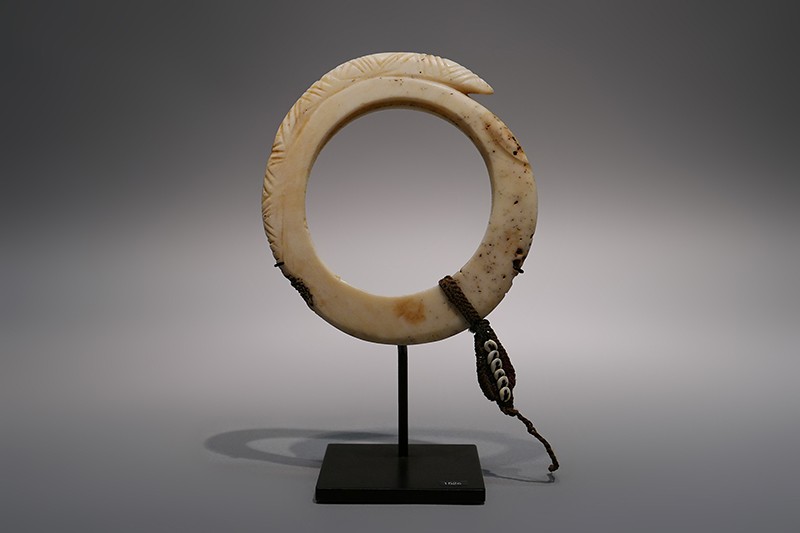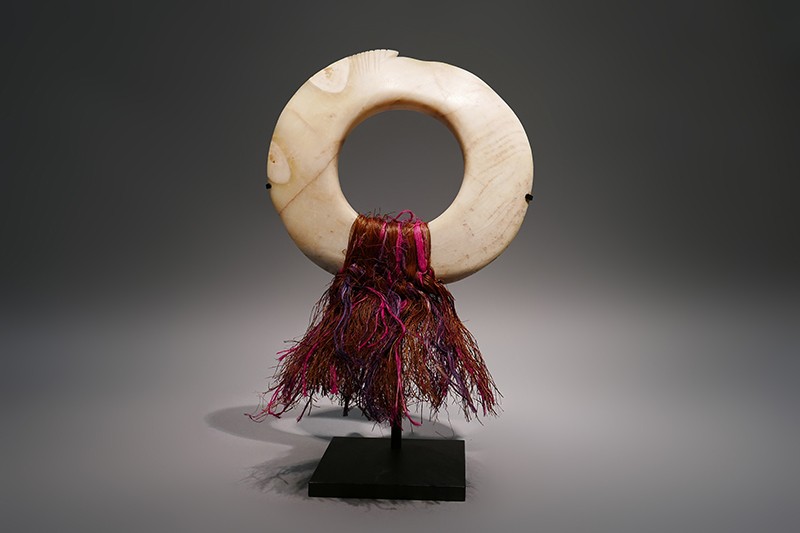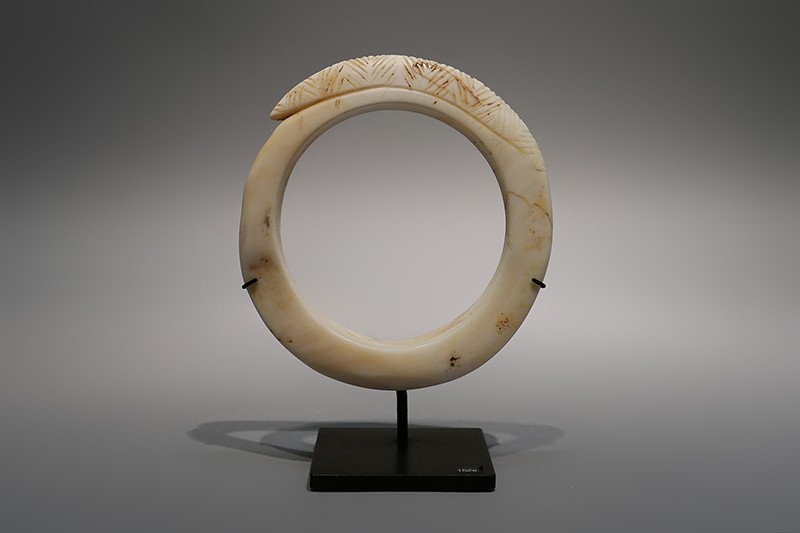2002 North Main Street
Santa Ana, California 92706
TEL: 714.567.3600
Shell to Pay: Boiken Wamayuwa and Weingga
 |
| Shell Currency (Wamayuwa), 19th Century Yangoru Boiken culture; Prince Alexander Mountains, East Sepik Province, Papua New Guinea, Melanesia Shell (tridacna gigas); 9 7/8 x 8 ¼ in. 2018.13.63 Gift of Anne and Long Shung Shih |
All the Money in the World
The Bowers Blog has spent a great deal of time exploring currency in its myriad shapes and sizes. From the throwing knife currency of Cameroon, to the glass rings of Indonesia’s Cenderawasih Bay, to the feathered money from Santa Cruz Island, we have seen that anything that can be given to another can serve as an inter- or extra-culturally traded monetary system. While it may be a barely recognizable cousin to the paper and coin currency used in the United States, the various shell monies used as bride price by the Boiken-speaking inhabitants of Papua New Guinea’s Prince Alexander Mountains and Sepik Plains are every bit as functional a medium of exchange. In this post we look at two varieties of shell ring created by two Boiken cultural groups, the wamayuwa or yua of the Yangoru Boiken and the weingga of the Kubalia Boiken.
 |
| Shell Currency (Weingga), 19th Century Kubalia Boiken culture; Sepik Plains, East Sepik Province, Papua New Guinea, Melanesia Shell (tridacna gigas and nassa) and fiber 2018.13.67 Gift of Anne and Long Shung Shih |
Not Spared Change
When previously discussing the Boiken, the blog has focused on the language group’s ceramics. The reason behind this is unfortunately not a happy one. Unlike many of the other cultural groups in the East Sepik Province, the shock of being suddenly thrusted into a larger world hit Boiken crafting traditions hard. Lines of expert woodcarvers that may have been active for hundreds of years ceased creating new objects within the span of a few decades. Globalization worked as an invasive species to route just about all Boiken arts. By the 1980s when ethnographers began to seriously look at Boiken the culture, very little of their traditional arts remained. What further complicates this is that due to the longstanding lack of research on Boiken art, many Boiken objects were misidentified as either Abelam or Arapesh, two groups neighboring the Boiken. It is only in the past few years that museums and Oceanic experts have reexamined objects from the region and traced their origin back to the Boiken.
 |
| Shell Currency (Wamayuwa), 19th Century Yangoru Boiken culture; Prince Alexander Mountains, East Sepik Province, Papua New Guinea, Melanesia Shell (tridacna gigas) and dyed raffia; 13 ¾ x 9 ½ in. 2018.13.61 Gift of Anne and Long Shung Shih |
Put a Ring on It
Some Papuan currency were used in regular transactions, but the vast majority of exchange pieces were only traded on a few occasions: marriage feasts, purchasing high-value items such as pigs, and as bride price—among the Boiken, bride price was certainly the most important. Bride price is perhaps easiest explained as being equal but opposite to the dowry of pre-modern Europe. In Melanesian societies, it was the duty of the man’s family to pay for his bride. The rationale behind this is that in most Papuan cultures, one marries outside of their immediate village. For a woman marrying a man means she must leave her community. Bride price serves as compensation for the years of time and resources a community puts into a woman before she reaches adulthood. Bride price ceremonies involve a man usually throwing a feast, and then offering his potential wife’s family pigs, and bride price pieces such as this post’s yua and weingga.
 |
| Shell Currency (Weingga), 19th Century Kubalia Boiken culture; Sepik Plains, East Sepik Province, Papua New Guinea, Melanesia Shell (tridacna gigas) 2018.13.66 Gift of Anne and Long Shung Shih |
Great Gigas
Both wamayuwa—yua is a shortened phonetic spelling of this word—and weingga are traditionally made from the shell of tridacna gigas, a species of giant clam that lives in the coral reefs surrounding Papua New Guinea. Raw shell would be traded from coastal Boiken, to groups living further inland such as the Yangoru Boiken. Giant clams can measure over 45 in. across, so thinner sections are cut from shell slabs by using bamboo cord as if it were a saw. Once the piece has been properly sized a hole is drilled in its center using a stock of bamboo. The edges are then smoothened using silica sand, giving the final shell currency pieces their incredibly clean aesthetic. Exploitative fishing of tridacna gigas in the past century mean that few examples of tridacna shell currency are younger than a century old. These pieces certainly were all made during the late 19th or early 20th Century. More contemporary examples of yua are sometimes made from porcelain or white marble. With the wamayuwa used by the Yangoru Boiken, the incisions are added each time the piece is displayed at a feast or exchanged in a bride price ceremony. Kubalia Boiken rings tend to be slightly smaller, and both their protrusions and the notched carvings seen on these protrusions are intended to reference the beak of the hornbill bird.
Text and images may be under copyright. Please contact Collection Department for permission to use. References are available on request. Information subject to change upon further research.

Comments